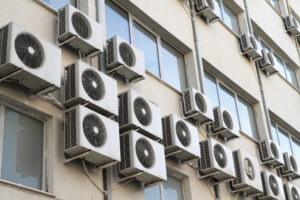 As the global demand for technology rises, the cumulative impact of electrical gadgets on indoor and outdoor temperatures is becoming a significant but often overlooked factor in urban climate dynamics.
As the global demand for technology rises, the cumulative impact of electrical gadgets on indoor and outdoor temperatures is becoming a significant but often overlooked factor in urban climate dynamics.
While large-scale contributors to global warming such as industries, automobiles, and air conditioners are well known, the smaller yet widespread heat emissions from daily-use electronics also add considerably to the environmental thermal load. Devices like laptops, smartphones, refrigerators, and televisions continuously release heat during operation. A typical laptop emits between 15 and 45 watts of heat when used, and in an office with around 50 employees, this translates to approximately 2.25 kilowatts—equivalent to a small room heater operating throughout working hours.
Smartphones, despite their compact size, contribute as well. When used intensively, such as during gaming or video calls, these devices can generate 2 to 6 watts of heat. Considering millions of users worldwide, this amounts to hundreds of megawatts of heat released daily.
Refrigerators, designed to cool their interiors, paradoxically discharge substantial heat into the surrounding space. Depending on the model, they consume between 100 and 800 watts, with most of this energy ultimately released as heat into kitchens or living rooms. Large-screen televisions similarly consume between 100 and 400 watts, which also contributes to indoor heating.
Other household and office electronics—including gaming consoles, microwave ovens, routers, washing machines, and dryers—add to this heat generation. According to the International Energy Agency (IEA), appliances account for roughly 25 to 30 per cent of residential electricity consumption in developed nations, a significant share of which results in heat emissions.
Urban structures exacerbate this problem due to poor ventilation and the widespread use of heat-retaining materials such as concrete and glass. The heat generated indoors raises temperatures, prompting increased use of air conditioning systems. These systems, while cooling interiors, release absorbed heat outdoors, elevating ambient temperatures and increasing energy demand further.
In the United States alone, air conditioners are responsible for approximately 117 million metric tons of carbon dioxide emissions annually and consume about six per cent of total generated electricity. Warmer regions such as India and West Asia witness even higher usage rates. Moreover, many air conditioning units still operate with hydrofluorocarbon refrigerants—potent greenhouse gases with high global warming potential.
The production and disposal of electronic devices add to this environmental strain. The mining of rare earth elements, manufacturing of circuit boards, and assembly of gadgets emit large quantities of greenhouse gases. Improper disposal also poses risks. In 2021, global electronic waste reached 53.6 million metric tons, much of which was incinerated or landfilled improperly, releasing harmful substances and heat into the atmosphere.
Studies indicate that regions with dense concentrations of electronics such as commercial hubs and technology districts exhibit noticeably higher localized temperatures compared to residential zones. In cities like Tokyo, anthropogenic heat from electronic usage has been found to contribute up to 15 per cent of urban warming.
Addressing this issue requires more efficient device design, improved cooling infrastructure, and a shift toward energy-conscious user behavior. Recognizing the thermal footprint of everyday electronics is crucial as urban centers worldwide confront rising temperatures and escalating energy demands.
